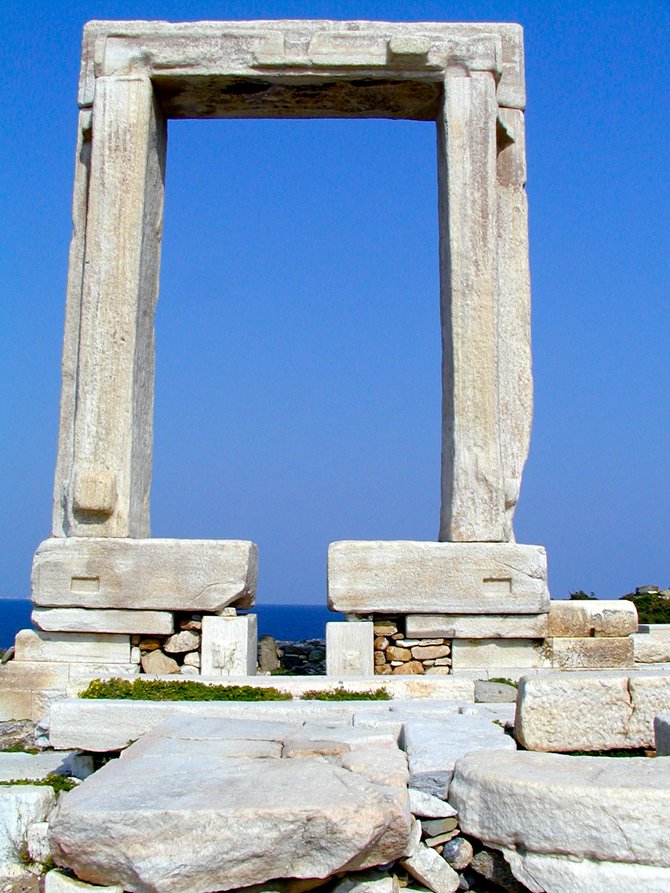 Facebook
Facebook
 X
X
 Instagram
Instagram
 TikTok
TikTok
 Youtube
Youtube

The island of Naxos, Greece, is a six-hour ferry ride from Piraeus, the port of Athens. The “doorway” to the island, the gigantic Portara, was also the portal to the ancient unfinished Temple of Apollo. Stand underneath it and make a wish.
It’s advisable to stay at least two or three days in Naxos if you want to take in the main points of interest. I opted for convenience at the Hotel Coronis, with balcony views of the harbor where I could walk to the restaurants and shops, take a bus or rent a car.
After you’ve refreshed yourself at one of the beachfront cafes or bars, explore the town of Naxos. Head up the hill, past the whitewashed houses to the Venetian Kastro, where you’ll find several residences, a 13th-century cathedral and the French School, where renowned Greek author Nikos Kazantzakis studied. The former school is now the Archeological Museum, which houses a fine collection of white-marble Cyclades sculpture.
The towns, beaches and archeological sites of Naxos can be easily reached by bus or car. One of my favorite spots lies just outside the village of Ano Sagri, overlooking a fertile valley – the sanctuary of Demeter, goddess of fertility and the harvest, dating back to 530 B.C.
Apeirathos is a traditional village settled by the Cretans, where a labyrinth of narrow marble streets leads to a great taverna, the Platanos. Halki is the home of the old Ballindras Citron and Ouzo factory, as well as the Church of the Virgin Mary with its wonderful frescoes. Another popular destination, in an ancient quarry above the village of Apollonas, is the 28-foot-high marble Kouros sculpture.
The best sandy beaches are along the west coast of the island. Agios Georgios is the main tourist area, and the quieter Agios Prokopis and Agia Anna, with their turquoise blue waters, are considered two of the most beautiful beaches in Greece. A photographer’s heaven!


The island of Naxos, Greece, is a six-hour ferry ride from Piraeus, the port of Athens. The “doorway” to the island, the gigantic Portara, was also the portal to the ancient unfinished Temple of Apollo. Stand underneath it and make a wish.
It’s advisable to stay at least two or three days in Naxos if you want to take in the main points of interest. I opted for convenience at the Hotel Coronis, with balcony views of the harbor where I could walk to the restaurants and shops, take a bus or rent a car.
After you’ve refreshed yourself at one of the beachfront cafes or bars, explore the town of Naxos. Head up the hill, past the whitewashed houses to the Venetian Kastro, where you’ll find several residences, a 13th-century cathedral and the French School, where renowned Greek author Nikos Kazantzakis studied. The former school is now the Archeological Museum, which houses a fine collection of white-marble Cyclades sculpture.
The towns, beaches and archeological sites of Naxos can be easily reached by bus or car. One of my favorite spots lies just outside the village of Ano Sagri, overlooking a fertile valley – the sanctuary of Demeter, goddess of fertility and the harvest, dating back to 530 B.C.
Apeirathos is a traditional village settled by the Cretans, where a labyrinth of narrow marble streets leads to a great taverna, the Platanos. Halki is the home of the old Ballindras Citron and Ouzo factory, as well as the Church of the Virgin Mary with its wonderful frescoes. Another popular destination, in an ancient quarry above the village of Apollonas, is the 28-foot-high marble Kouros sculpture.
The best sandy beaches are along the west coast of the island. Agios Georgios is the main tourist area, and the quieter Agios Prokopis and Agia Anna, with their turquoise blue waters, are considered two of the most beautiful beaches in Greece. A photographer’s heaven!
Comments